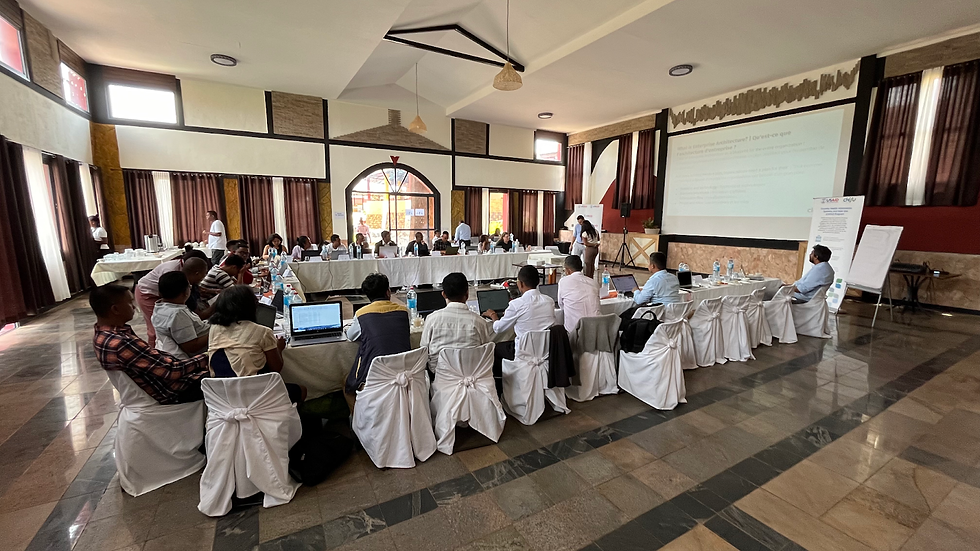Collaborating on Enterprise Architecture for Better Healthcare in Madagascar
- Zane Dickens

- Aug 13
- 3 min read

Madagascar is working to strengthen its healthcare system in the face of complex challenges.
Many communities live far from health facilities, and poor road conditions make travel difficult. Rural clinics often operate with limited staff and resources, making it harder to diagnose and treat common conditions like malaria and tuberculosis.
Health information systems, while growing, are not yet fully connected, making it challenging to share data quickly and respond effectively to outbreaks.
Against this backdrop, a five-day Enterprise Architecture (EA) workshop in Antananarivo brought together more than 60 stakeholders from across the digital health sector.

Co-facilitated by Jembi Health Systems, the Country Health Information Systems and Data Use (CHISU) program, USAID, and Madagascar’s Ministry of Health, the workshop focused on practical ways to integrate systems, improve data flow, and strengthen governance. It was a step toward turning Madagascar’s National Digital Health Strategy into tangible improvements for healthcare delivery.
Enterprise Architecture offers a blueprint for how all parts of the healthcare system can connect and work together. For Madagascar, this means:
Helping health facilities share patient information safely
Ensuring technology investments lead to real improvements in patient care
Equipping healthcare workers to use digital tools effectively
Supporting the rollout of digital medical records and other essential technologies

From Vision to Action
The workshop followed a clear, structured approach, splitting participants into three parallel tracks:
Two dedicated to developing a shared EA vision
One focused on EA governance
In small-group breakout sessions, participants mapped Madagascar’s current healthcare systems, asked hard questions about system integration, set priorities for health data, and examined how governance structures could better support long-term change.
Drawing on CHISU’s experience in Kenya, Ethiopia, and Indonesia, Jembi’s team (Ryan Crichton, Tresor Mvumbi, and Wayne Naidoo) shared lessons learnt from other countries’ digital health journeys. This helped participants see how Madagascar’s plans fit into the broader global health landscape while staying rooted in local realities.
By the end, the workshop produced a clear vision for the future and aligned next steps with the country’s National Digital Health Strategy, turning broad ambitions into actionable plans.

Overcoming Challenges Together
The path wasn’t smooth. Power cuts interrupted sessions, and translation between languages added layers of complexity to technical discussions. But rather than slowing progress, these challenges revealed the commitment in the room.
Participants adapted quickly, showing resilience and a shared determination to reach their goals. By the final day, they had achieved tangible milestones: a draft conceptual Enterprise Architecture diagram and early agreements on key principles for system access and data priorities.
Beyond Technical Solutions
While the technical outputs were important, the workshop’s most significant contribution may have been human. It brought together stakeholders who rarely work side by side. Building trust, mutual understanding, and a sense of shared ownership over the country’s digital health future.
Concrete outcomes included:
A comprehensive gap analysis comparing current systems with the target EA vision
A jointly developed EA vision endorsed by all stakeholders
A draft conceptual Enterprise Architecture diagram
A clearer understanding of how EA can directly improve healthcare delivery
These results give Madagascar not just a plan but a stronger network of people committed to making it work.
The Road Ahead
The next steps will be led by Madagascar’s own governance team, carrying forward the workshop’s momentum. The timeline is clear:
Late January 2025: Complete detailed data collection
February 2025: Finalise the first draft of the Enterprise Architecture
March 2025: Refine and improve the plan
April 2025: Secure official approval of the architecture
If implemented well, these steps could lead to healthcare that is easier to access, more efficiently organised, and better equipped to keep communities healthy.
The closing ceremony, with formal addresses from USAID and UN representatives, underscored the significance of this effort not just as a technical exercise but as a milestone in Madagascar’s journey toward stronger, more connected health systems.
This initiative shows how careful planning, the right mix of expertise, and genuine collaboration can move a health system forward. The workshop was not an endpoint but an important step in Madagascar’s journey toward a health system that is connected, efficient, and accessible to everyone. The work ahead will be challenging, but the foundations for lasting change are now in place. |
For more information about Enterprise Architecture in healthcare, or to discuss similar initiatives, contact the Jembi Health Systems team.



